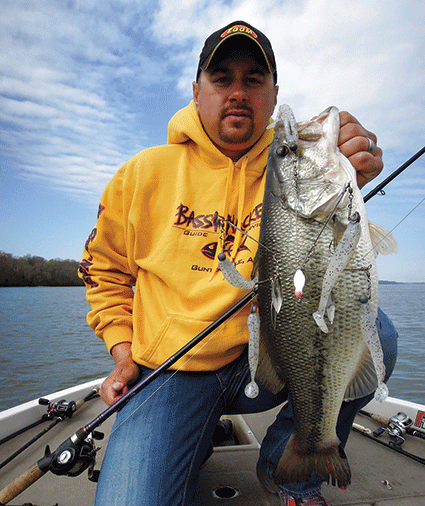
Guide Service in Guntersville, Ala., shows off
a largemouth bass he caught on an Alabama
rig. With multiple baits, an Alabama rig, also
called an umbrella rig, resembles a school of
baitfish swimming through the water.
Photo by John N. Felsher
By John N. Felsher
The best anglers in the world will compete on one of the best largemouth bass lakes in the world at the best time of the year for catching giant fish when the 2014 Bassmaster Classic visits Lake Guntersville on Feb. 21-23.
“Without a doubt, Lake Guntersville is one of the premier bass lakes in the nation,” says Mike Iaconelli, the 2003 Bassmaster Classic champion. “It’s an amazing numbers lake, but can also produce giant bass. In most lakes, we try to get about a 3-pound average in a tournament. On Guntersville, I’m not happy until I get about a 4- to 5-pound average.”
Lake Guntersville ranks Number 4 on the 2013 Bassmaster magazine list of the top 100 bass waters in the United States. Every year, Lake Guntersville produces many bass exceeding 10 pounds and countless largemouths in the 3- to 8-pound range. Charlie Bertus of Huntsville, Ala., holds the official lake largemouth record with a 14.50-pound lunker he caught on Feb. 21, 1990. Duanne McQueen of Stockbridge, Ga., landed the lake record smallmouth, a 5.85-pounder that he caught near the dam in 2010. The lake also holds Kentucky spotted bass approaching five pounds.
“The lake has always been a great bass lake, but in the past few years, it’s really exploded for big bass,” says Jonathan Henry (256-647-3532, guntersvillebasswhacker.com) with BassWhacker Guide Service in Grant, Ala. “It’s incredible how many big fish come out of that lake. I know of at least one 13-pounder weighed in during a 2013 tournament.”
Lake Guntersville snakes 75 miles along the Tennessee River through northeast Alabama into Tennessee. The largest lake in Alabama covers about 69,100 acres and drops to about 60 feet deep in places. Some better bass creeks include North and South Sauty, Siebold Creek, Brown’s Creek and Town Creek.
“The majority of fish that win tournaments on Lake Guntersville come from North Sauty Creek down to about Brown’s Creek,” Iaconelli says. “Guntersville is such a great lake because it has so much grass. With so many vast grass flats, much of the lake looks the same. I look for ditches. Water depth doesn’t really matter as much as depth change. It doesn’t even have to be a radical drop. Just a drop of a foot or two might make a difference.”
Some people punch through grass mats with heavy jigs. What might look like a dense, imposing raft on the surface may provide bass abundant maneuver room beneath the canopy. Frequently, thick mats limit sunlight reaching any other submerged vegetation growing beneath them.
“Bass feed heavily upon bream in the mats,” explains Gerald Swindle, a bass pro from Warrior, Ala. “In low light, I fish a 1/2-ounce jig. As the sun gets higher, I’ll switch to a 3/4-ounce and fish the thicker clumps. For the jig color, I stick with browns or greens. I like to fish the main river channel and flip the edges where hydrilla and milfoil mix with a little current moving through it.”
Besides grassy flats, anglers can also fish ledges, drop-off edges, humps, natural rock piles and docks. Bridges and riprap offer more cover. In the backs of creek, throw shad-colored crankbaits or spinnerbaits. Bang crankbaits off the rocks or work over the area with shaky heads or worms.
Big bass hang around the bait
“In the winter, big bass frequently hang around the bridges because that’s where the bait goes,” Henry says. “Find the bait and that’s where the big bass will be. In the winter, the best technique is to throw an Alabama rig. Anglers can also catch good fish on single swimbaits, jigs and crankbaits. Another good technique is a lipless crankbait.”
In late winter, bass begin moving from the depths to the shallows where they spawn in saucer-shaped beds hollowed out from the bottom. The smaller male bass typically begin moving shallow first to prepare the beds. The bigger females generally follow about two to three weeks later. A healthy female full of eggs could weigh several more pounds in February than in June after dropping her precious cargo.
“Winter through early spring is the best time to catch monster bass on Lake Guntersville,” Henry says. “In February, fish will be surprisingly shallow. Most bass will be in less than 10 feet of water, usually in two to eight feet of water. They’ll be staging before going to the spawning beds. The bigger fish start spawning around mid-March.”
While spawning, bass do not eat. However, before spawning, bass gorge themselves on shad and other baitfish to build up energy and strength for the arduous spawning process. For this reason, fishing fans should see some awesome catches during the Classic in February.
The professional bass anglers will compete for the $500,000 top prize and possibly millions in endorsements. After fishing, the anglers will haul their catches to the Birmingham-Jefferson Convention Complex in downtown Birmingham each day for the public weigh-in. For more information on the Bassmaster Classic, see www.bassmaster.com/tournaments/2014-bassmaster-classic.




